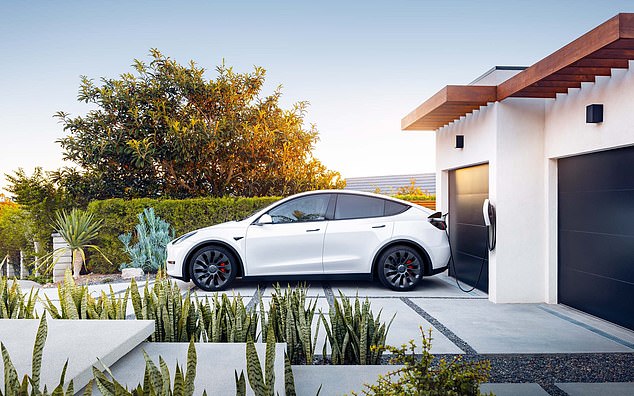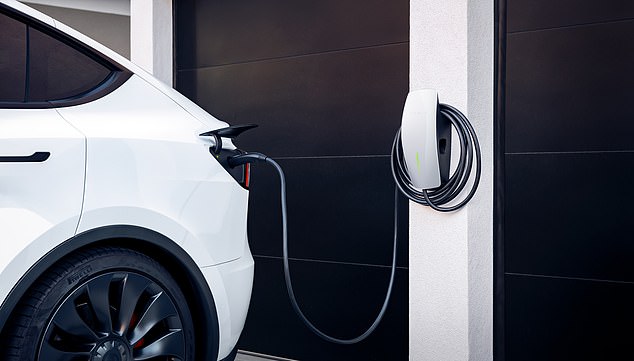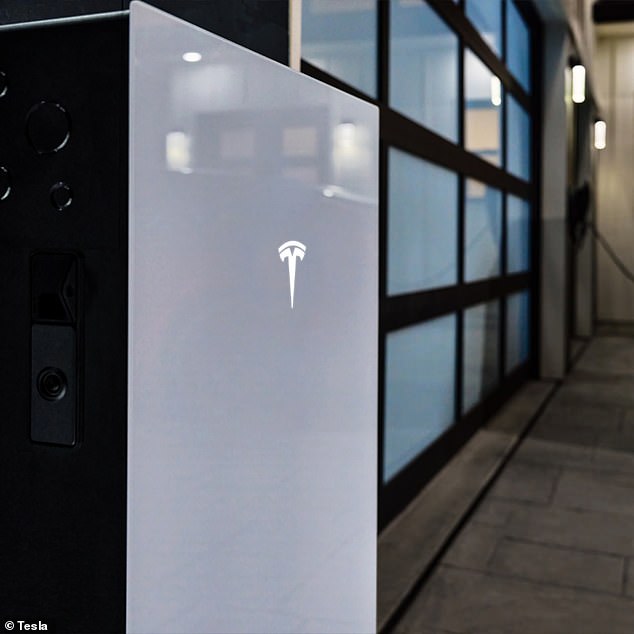Table of Contents
Tesla has launched its Powerwall 3 home battery in the UK, but how does it work? Can it really save you £1,450 a year on your energy bills?
Tesla Powerwall is a large rechargeable battery that mounts to the wall of a house and the third edition of the battery is now available for sale.
The Powerwall can It stores electricity for use at a later time, and households can use the device to save money on their energy bills.
This is everything you need to know about how Tesla Powerwall 3 works.
Power on: The Tesla Powerwall’s sleek exterior hides a battery that can power most homes
How does a Powerwall 3 work?
Powerwall allows homes to store solar-powered electricity, either through solar power or for use at time-of-use energy rates.
These rates are special energy deals that charge less for electricity used during off-peak periods, often at night.
Homes with a large battery installed, like the Powerwall, can take advantage of this by charging it when electricity is cheap and then using that power when electricity is more expensive.
Another advantage of the Powerwall is that it automatically detects power outages and activates.
When extreme weather conditions are forecast, the Powerwall 3 will charge to maximum. That energy can then be used to power appliances in the event of a power outage.
The device can still function when immersed in 60cm of water and in temperatures from -20°C to 50°C.
How much electricity can a Powerwall 3 store?
The Powerwall 3 can store up to 13.5 kWh of electricity when the new Tesla says so, dropping to 9.45 kWh after 10 years.
The average home uses around 7.3 kWh of electricity a day, according to energy regulator Ofgem, meaning a Powerwall should be able to comfortably power most homes on a full charge.
However, more than one Powerwall can be installed in homes with very high electrical needs.

Some context: The Powerwall can be installed on the exterior of most properties
How much does it cost?
The typical cost is £6,300 for a Powerwall 3.
This is made up of £5,500 for a Powerwall and a further £800 for the Tesla Gateway, which allows for energy metering and management and the ability for the Powerwall to activate during a power outage.
But the total cost will vary and customers can get more accurate quotes on the tesla website.
Crucially, the prices above do not include installation costs or VAT, meaning the price to install a Powerwall is likely to be in the region of £7,000 to £8,000.
How much can it save me on my energy bills?
Tesla claims the Powerwall 3 can save the average household £1,450 a year on their energy bills.
This is a significant saving, with the typical household currently paying £1,690 a year for energy, a figure that will fall to £1,568 a year from 1 July.
That means a home with a Powerwall could spend just £118 on energy bills a year from 1 July.
However, to achieve the £1,450 saving, a home would need to have solar panels installed.
Customers should also consider the installation costs of the Powerwall.
A £7,000 bill to install the Powerwall would mean a cost of £700 a year for a typical home, reducing Tesla’s claimed savings to around £750 a year at current energy prices.

You can use Powerwall to make your home charging more efficient, meaning you can benefit from having it installed if you own an electric vehicle.
Is the Powerwall 3 a home charger for electric vehicles?
No, the Powerwall 3 is an energy storage unit, not a home charger. But you can use Powerwall to make your home charging more efficient, meaning you can benefit from having it installed if you own an electric vehicle.
How does Powerwall benefit my electric vehicle charging?
If you have a smart home charger, you can schedule charging when your home exclusively uses excess solar energy, reducing your environmental impact and saving you money.
Also helpful is that the Powerwall 3 has a built-in solar inverter that will convert electricity from direct current (DC) to alternating current (AC); Electric vehicles use AC for home charging via a type 2 connector.
How much money will it save me on freight?
The exact amount will depend on the electric vehicle you have (you don’t need to have a Tesla) and how long it is charged.
Just as off-peak charging saves you money, charging using your Powerwall’s stored energy will significantly reduce the cost of charging your home.
As a guide, Octopus Intelligent Go, which offers renewable energy during off-peak hours, says it reduces home charging costs by 70 percent.
Will it make my electric vehicle more environmentally friendly?
If you charge using only the stored energy from your solar panels, then you will power your electric vehicle with clean renewable energy, making your electric vehicle more environmentally friendly.

Just as off-peak charging saves you money, charging using your Powerwall’s stored energy will significantly reduce the cost of charging your home.
How do I use Tesla solar charging?
Tesla has a Solar Charging option through the Tesla app that allows you to use excess solar energy produced by your Tesla solar system. Simply enter the charging limit and it will automatically charge your car up to the set limit using excess solar energy.
Just note that the 2012 to 2020 Model S and 2015 to 2020 Model X are not currently eligible for this feature.
Any other benefits?
Powerwall can step in if you ever have a power outage, meaning you’ll never have to worry about not being able to charge your electric vehicle if you have a power outage.
Some links in this article may be affiliate links. If you click on them, we may earn a small commission. That helps us fund This Is Money and keep it free to use. We do not write articles to promote products. We do not allow any commercial relationship to affect our editorial independence.



